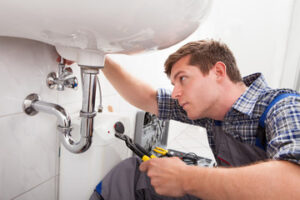Clearwater Plumbers install, repair, and maintain plumbing systems in residential and commercial buildings. This career requires critical thinking and problem-solving skills to identify the source of a leak or clog. It also demands physical strength to lift heavy equipment and work in tight spaces.

The path to becoming a plumber begins with a high school diploma or equivalent and an apprenticeship program that lasts two to five years. Most states require plumbers to be licensed.
Drains are vital for disposing of waste and ensuring that water flows efficiently throughout your home. However, they can become clogged with debris and contaminants that prevent water flow or lead to overflowing drains. Fortunately, plumbers can help. They have the skills and tools to thoroughly clean your drains and restore them to optimal function.
One of the most common drain cleaning services that plumbers offer is drain clearing. This procedure involves removing clogs from the pipes with dedicated machinery. The plumbing professional uses a snake that is composed of small sharp metal blades powered by a motor and attached to a durable cable. The plumber then inserts the snake into the drain pipe until it reaches the clog, where it cuts and removes the clog. Once the clog is removed, water will flow freely through the pipe.
Some types of clogs require more advanced techniques. These include using a chemical drain cleaner that dissolves organic matter like hair, soap scum and food particles. Some plumbers also use a portable drain auger that is pulled through a pipe to dislodge hard obstructions. This equipment looks like a large drill and is useful for removing large clogs that might otherwise be difficult to reach with other devices.
Often, a simple drain cleaning with baking soda and vinegar is enough to clear away minor blockages. Regularly performing this household task will keep your drains in good condition and prevent future clogs.
Other more serious clogs may require the use of an industrial drain cleaner. These products contain dangerous chemicals that must be handled carefully by a plumbing professional. These cleaners typically involve a stronger acid than store-bought drain cleaners and are used to remove tough clogs that have formed from substances like grease, broken pipes and roots. Clogs from these substances can be particularly destructive to pipes, as they can cause the joints and seals to deteriorate and leak.
Sewer Cleaning
Sewer cleaning is the process of removing waste and debris from your sewer lines. Your plumber will use professional-grade equipment to clean out the pipes and restore them to proper function. This service is necessary to prevent clogs, overflows, and other dangerous conditions. Typically, your plumber will start by inspecting the sewer lines with a CCTV crawler that relays video back to a monitor in the truck. This will allow your plumber to see the inside of the pipes and determine the best method for cleaning them.
Unlike drain lines, which are usually visible, your home’s sewer lines are located underground and out of sight. These lines are responsible for carrying all of the wastewater from your home and business to the sewage treatment plant. Debris can get into the line from toilets, sinks, and other fixtures, and cause blockages that prevent wastewater from flowing properly. This can lead to overflowing toilets, gurgling sounds in the plumbing, and the smell of rotting waste.
A plumber will typically use one of two methods for sewer cleaning: cable or hydraulic. With a cable, your plumber will push a special cable through the sewer pipes until it gets to the clog. This can remove large blocks of debris like sand, gravel, roots, and soil. If the clog is particularly severe, your plumber may have to dig up and replace part of your sewer line.
For smaller clogs, your plumber may choose to use a hydro-jetting service. This method uses high-pressure water to clear out the clog and wash away any remaining debris in the pipe. This is a safe and effective option for your sewer pipes and does not require digging or breaking through drywall.
It is important to note that your plumber will only use professional-grade tools and equipment for sewer cleaning. Do-it-yourself chemical drain cleaners are not recommended as they can damage your pipes and cause more problems down the line. Your plumber will also never use harmful chemical solutions in your drains and toilets, as these can contaminate your drinking water and pollute the environment.
Drain Repairs
Drains are an unsung hero of the plumbing system, whisking away waste and keeping water flowing smoothly. But over time, they can become clogged or damaged and require repair. Plumbers offer a variety of drain repair services, from clearing away simple clogs to replacing damaged pipes. Choosing the right plumber for your drain repair can mean the difference between peace of mind and costly repairs down the road.
The first step in any drain repair is to determine the cause of the problem. For example, a clogged drain may be caused by hair, soap scum, grease, or food scraps that solidify in the pipe and restrict flow. On the other hand, a broken drain could be caused by an underground blockage, ground shifting, or tree roots. A plumber will be able to use a camera to inspect the interior of your pipes and determine the source of the issue.
Once they have figured out what the issue is, the plumber will be able to recommend a course of action. In some cases, the plumber will be able to clear the clog using a power drain cleaner or snake. But if the problem is more severe, they may need to excavate the entire line and replace it. In this case, it is important to choose a plumber with experience and knowledge of different types of pipe material.
When selecting a plumber for drain repair, make sure they are licensed and insured. Also, look for online reviews, testimonials, and ratings to gauge their level of professionalism and quality of work. Finally, make sure they provide timely repairs to minimize inconvenience.
A drain that isn’t functioning properly can lead to serious damage and health risks. Whether it’s slow drainage, foul odors, or bubbling and gurgling sounds, a professional plumber can fix the issue quickly and efficiently so you can get back to your regular routine. So if your drains are acting up, call in a professional plumber before the problem gets worse. They’ll have the tools and expertise to tackle any drain repair job. And they’ll get it done right the first time.
Drain Replacement
The drain pipes that carry wastewater out of your home may need to be replaced at some point. Your plumber will evaluate your home’s drainage system and recommend the best option for you. Some warning signs that your sewer lines are in trouble include frequent clogs, water backing up into multiple fixtures at once, or a foul sewage smell. If you notice these signs, call your plumber right away to avoid serious damage and health hazards.
Plumbing drain pipe replacement is a significant investment, but it can help prevent future problems and improve your home’s energy efficiency. Plumbers offer several different options for replacing your drain pipes, including trenchless methods that minimize disruption to your property. Your plumber will also provide you with maintenance tips and recommendations to extend the life of your new pipes.
If you’re experiencing frequent clogs or water backups, your sewer drains may need to be replaced. Your plumber will use specialized equipment to remove or break up the clog and then clean or replace your drain pipe. For severe clogs, your plumber might need to access the pipes directly using tools like powered drain augers or high-pressure water jets.
Another sign that your drain pipes are failing is if you see standing water in your yard or notice spongy ground beneath your feet. Leaking sewage can cause soil to shift and swell, which may lead to foundation cracks. In these cases, a drain pipe replacement is needed to restore the integrity of your home’s structure.
Your kitchen and bathroom drain pipes are usually the quickest and easiest to repair. Your plumber may be able to reach these pipes through existing openings, such as the sink cabinet or bathtub wall. Bathroom and basement drain pipes are more difficult to access, and your plumber may need to dig out the existing pipe and install a new one.
Sewer drain pipes are designed to last for decades, but they can eventually deteriorate and need to be replaced. Your plumber can recommend the best option for your home, based on its age and the material of the original pipe. The most common type of sewer drain pipe is PVC, which has a lifespan of 20 to 30 years. Other options include copper, galvanized steel, and black iron.


